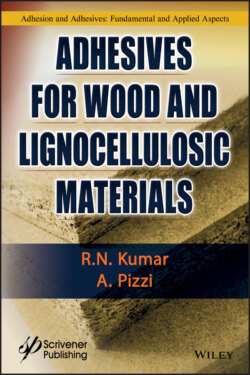Читать книгу Adhesives for Wood and Lignocellulosic Materials - R. N. Kumar - Страница 68
2.16 Measurement of the Wetting Parameters for Wood Substrate
ОглавлениеUnlike other substrates, wood exhibits complex anatomical features that make it heterogeneous and porous. It is basically hygroscopic. It contains extractives.
As a result of these unique physicochemical characteristics, wetting measurements on wood is difficult. Direct measurement of contact angle of adhesives on wood surface may not be reproducible and hence not satisfactory. For example, a drop of water on a wood surface will, in most cases, quickly change its size and shape over time, which will thus lead to a change in the contact angle.
New methods for determining the wetting parameters of wood are necessary. A detailed and critical review of the various methods to determine the wetting parameters have been reported by Magnus Wålinder. The readers may refer to the same [37]. A brief summary from the above review is given below.
“One way to address some of the difficulties in wood wetting measurements may be to apply the Wilhelmy (1863) method [38]. In contrast to direct measurement of contact angles, as in the drop method, the Wilhelmy method involves determining the force acting on a specimen when it is immersed in and withdrawn from a liquid. An apparent contact angle can then be estimated from an analysis of the recorded force”.
“Other promising techniques for estimating the surface energetics of wood may be the Axisymmetric Drop Shape Analysis-contact diameter (ADSA-CD) technique. Contact angle measurements determined as constant wetting rate angle values (cwra) and also a capillary rise technique (column wicking) applied to wood”.
“Inverse gas chromatography (IGC) is a useful technique for determining surface energetics of particle surfaces. By using appropriate gas probes, IGC can provide information on the surface thermodynamic characteristics of particles including surface free energy, acid-base interactions, enthalpy, and entropy. IGC has been applied to many materials such as polymers, wood pulp and wood particles”.
Some spectroscopic methods, namely, X-ray photoelectron spectroscopy (XPS) and FT Raman, have also been recommended by the author.
Both IGC and wicking methods rely on wood powder, which will give different results compared to measurements on solid wood.
